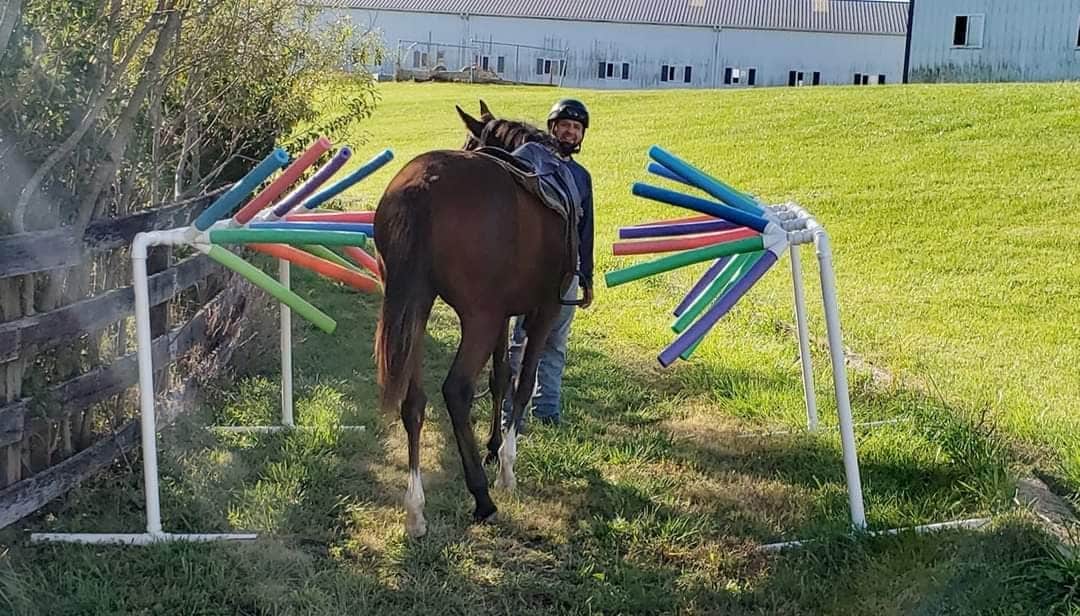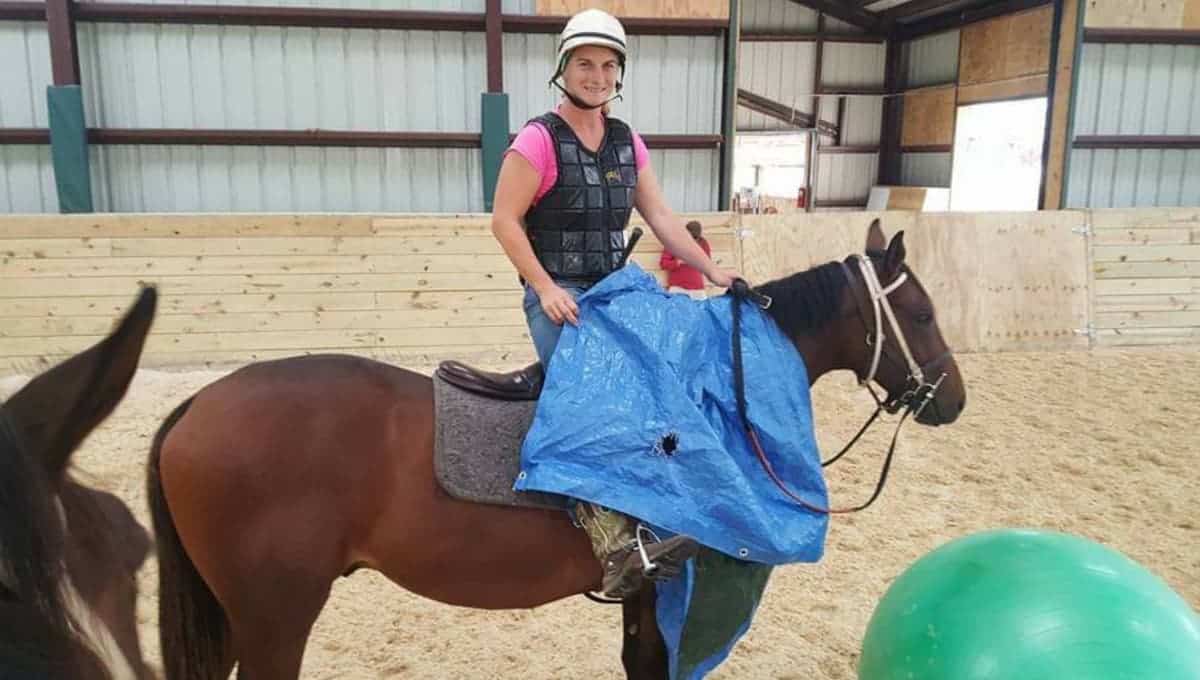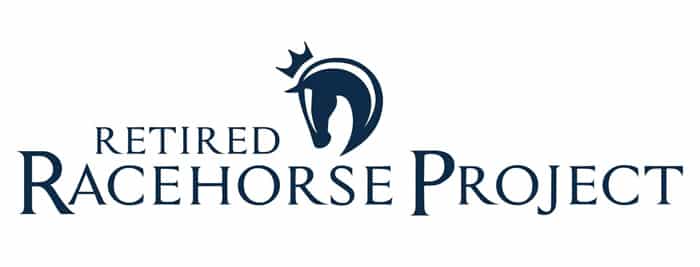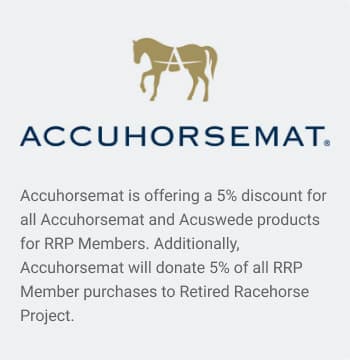Learn how one husband and wife duo gives future racehorses a sound start for the track and beyond

Toby and Heather use objects like tarps, pool noodles and balls to get horses used to unusual things and to teach them not to overreact. Photo courtesy Heather Richard
When Justify became the 13th Triple Crown winner in 2018, he did it with the help of many people. His lessons began, however, when Toby and Heather Richard, then with WinStar Farm, first introduced the colt to a saddle and bridle as a yearling.
Though some think racehorses don’t receive as thorough a foundation as horses destined for show disciplines, the basics are surprisingly similar. Toby and Heather believe the better they prepare a young horse, the better he will be as a racehorse, as well as in any secondary career he attempts after his racing days.
Today Toby and Heather run their own Dream Makers Colt Starting, in Lexington, Kentucky. Both have worked extensively at the racetrack as exercise riders, and Toby rode the stallions as part of his job at WinStar. Heather’s background includes barrel racing, jumping and eventing, as well as serving as an assistant trainer at the track.
The couple, who are raising a family, start about 130 horses a year, and not just Thoroughbreds. Recently, Toby and Heather started a group of Andalusians for a client. The principles they use remain the same, no matter what the horse is destined to do.
Day 1
Clients usually send Thoroughbred yearlings to the Richards in the fall. In Kentucky, Keeneland conducts a large yearling sale in September, and sometimes the yearlings go straight from the sale to Dream Makers. Other clients might first want to turn yearlings out for a while.
The schedule is up to the client and can depend on whether the horse is being readied for a 2-year-old sale early the following year. A horse’s pedigree might also indicate whether he’s a candidate for early racing as a 2-year-old or needs more time to grow — certain bloodlines are known for quicker musculoskeletal development.
Toby begins the training process in the horse’s stall. He uses a rope halter, with knots that rest on pressure points around the nose, and a lead rope.
“I do a lot in the first three days,” says Toby. “I’m getting to know them, let them smell me. I’ll blow in their nose and let them smell my breath.”
At the same time, he is teaching them to push forward and travel around him in a circle, both directions. He gives them rudimentary lessons about rein cues, even though at this point he is only using the lead rope.
“I’m lightly teaching them the signal with my hand,” he says. “I want their butt to push away from me and their nose to come toward me.”
Toby keeps his touch very light.
“If they can feel a fly, they can feel all of this,” he says. “They’re real sensitive animals. You don’t have to be pulling on them too hard — just kind of letting them dance.”
All of that usually only takes five to 10 minutes, and if all goes well Toby gets on the horse bareback in the same session. He employs desensitizing techniques to get horses used to him being around them, putting one of his arms across the back and letting the horse feel his weight. Then Toby slides onto their back smoothly, without pushing them if they aren’t ready.
“They might get a little bit startled at the most, but they don’t try to buck because they’re not cinched up,” he says.
Using the principles of never overdoing the lessons and always ending on a positive note, Toby works with each horse to the extent that he feels is right for that individual. At all stages he tries to build trust.
Early Lessons
The next day, Toby puts a surcingle and pad on the horse as the first step toward a saddle and girth. He might or might not get on them, depending on how they take to the gear. He also moves the lessons to a round pen if he feels the horse is ready.
“We always try to reintroduce each lesson each day,” says Heather. “They’re very smart animals and, if you make the questions simple, they can answer correctly. They’ll soak it up.”
What might surprise nonracing people is how much desensitizing work Toby and Heather do. They use objects like tarps, pool noodles and balls during the process to get horses used to unusual things and to teach them not to overreact.
“We start the horses like they’re regular horses because after their racetrack life, they’re just going to be regular horses again,” says Heather. “When they’re young, they’re so willing and observant and interested.”
Adds Toby, “We try not to get in their way and to let them become everything that they can. That’s one of our objectives — to get each horse to reach his full potential.”
The Richards add a saddle and stirrups on the third day but do not put a bit in a horse’s mouth until after at least 10 rides, as always, depending on the individual. They use an exercise saddle — basically a lightweight English saddle.
“They don’t need a bit,” says Toby. “They can turn their nose to me, they’re real soft in my hands, they stop fine. I’m trying to get that softness. I want them bending and flexing toward me, giving me their eye and their ear. I want them supple.”
Round pen lessons might also include longeing and ground driving. Toby and Heather add in more lessons as the horse progresses. They have a small starting gate and teach the horses to walk through it. The horse’s trainer will continue those lessons at the track, teaching the horse to accept the doors of the gate closing and then break out of them at speed.
Toby and Heather have access to trails, which they use when the horse is ready. There will be time enough for speed later. From those early lessons on trails, a horse learns manners, trust and confidence. He can also learn to maneuver around or over obstacles, such as fallen trees or branches.

Toby and Heather use objects like tarps, pool noodles and balls to get horses used to unusual things and to teach them not to overreact. Photo courtesy Heather Richard
A 90-Day Program and Beyond
Usually, Toby and Heather put 90 days on a yearling, though in some cases it could be as few as 60 days.
“Ninety would be best because you can put more miles on them,” says Toby. “The miles make the horse.”
Toby chooses the horses that are better-suited for Heather’s riding style, and they often ride horses together in the round pen.
“For a young horse to see a rider on another horse is very interesting,” says Heather. “They’re conscious about that.”
The sessions help the horses learn to navigate around one other, ridden, which is a different kind of experience than being pastured with other horses.
“Even going next to each other head and head is tough for them,” she says. “Some will suck back, and some will go forward.”
Heather compares those lessons to drill teams or circus acts. The horses travel toward each other and then they pass the other horse.
Once horses begin to train at a racetrack, they will see many horses and riders. The more they can get used to that in a quieter setting, the less they will jump around and possibly get into trouble at the track.
Toby and Heather even teach yearlings to sidepass so they can be maneuverable for such tasks as helping their rider open the gate to the round pen, “like a ranch horse,” says Toby.
“All my babies go through an obstacle course, all my babies move off of my legs,” he adds. “I keep them as light as I can and as soft as I can for as long as I can. They’re useful, good horses.”
Lessons toward the end of the 90 days can include galloping off with a group after lining up so they begin to learn to break with a pack like they will in a race. Toby also will raise his voice while keeping the horse calm with his legs and his body language to simulate the noise they will encounter at the racetrack.
“We are teaching them to trust their rider,” says Heather. “The rider has guided them through a lot of obstacles safely.”
Eventually, usually after they leave Toby and Heather’s care, Thoroughbreds will be taught to race and get up into the bridle. After their racing careers, horses will need to unlearn some of those lessons so they can segue to a hunter/jumper, trail, ranch or other second career.
But because of the good foundation Toby and Heather gave them, the horses will likely remember those early lessons, making the transition easier.
This article was originally published in the Summer 2021 issue of Off-Track Thoroughbred Magazine, the only publication dedicated to the Thoroughbred ex-racehorse in second careers. Want four information-packed issues a year delivered to your door or your favorite digital device? Subscribe now!


